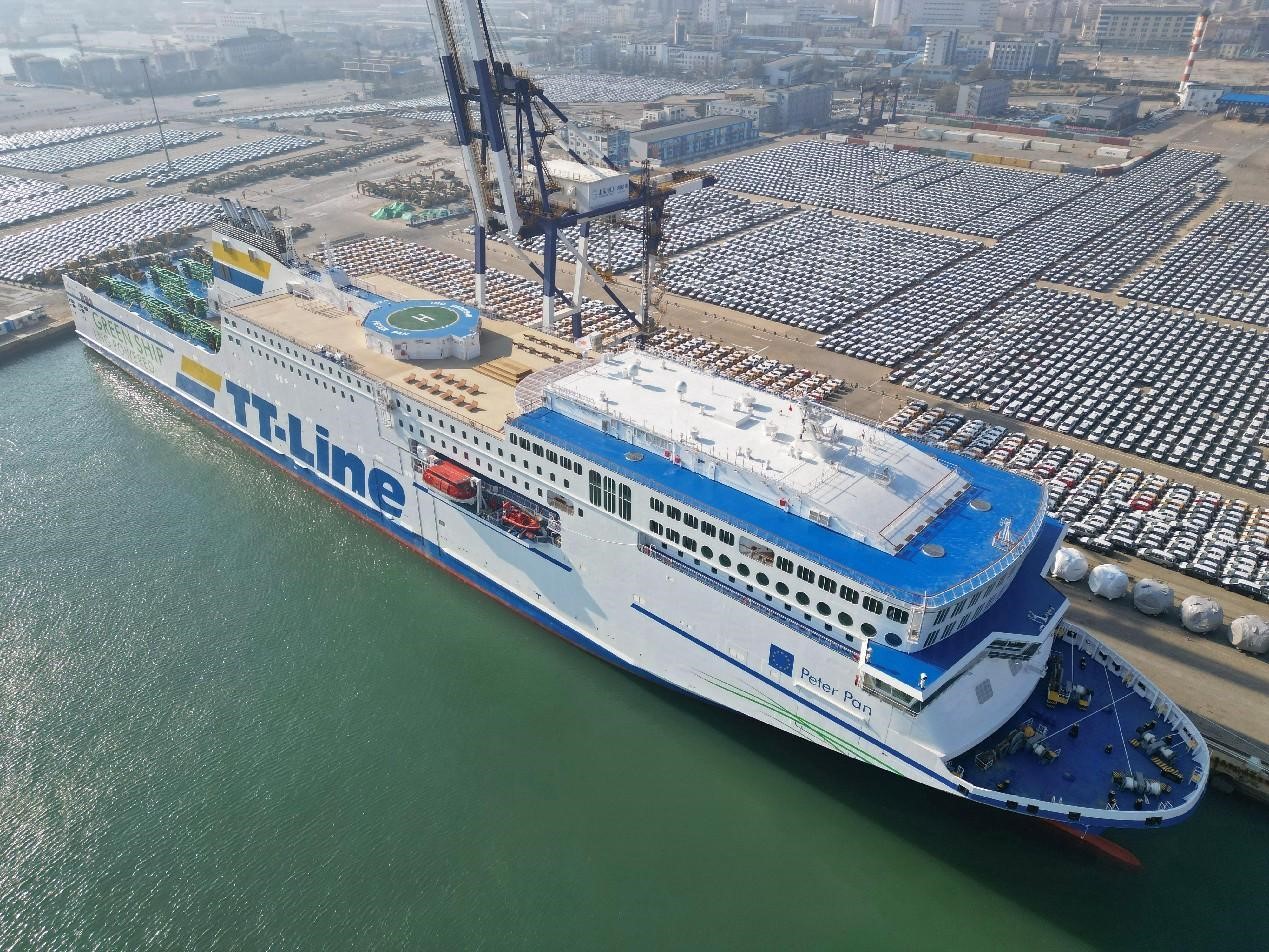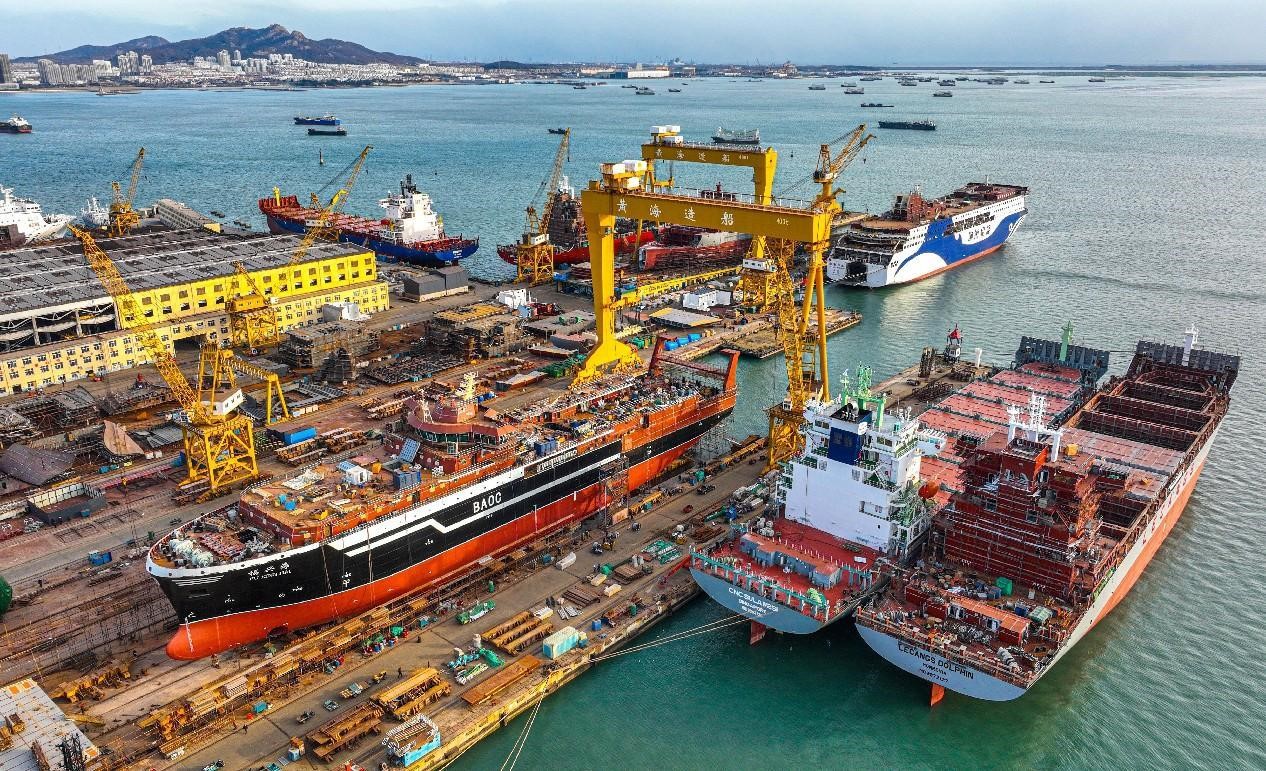Shipbuilding orders demonstrate great strength of Chinese manufacturing

An ultra-large container vessel with a capacity of 24,116 TEUs (20-foot equivalent units) undocks at Changxing Shipbuilding Base in east China's Shanghai. (Photo/Official website of Hudong-Zhonghua Shipbuilding [Group] Co., Ltd.)
Not long ago, an ultra large container vessel with a total length of 399.99 meters and a deck area equivalent to the combined size of nearly four standard soccer fields undocked at the Changxing Shipbuilding Base in east China's Shanghai.
The ship, with a capacity of 24,116 TEUs (20-foot equivalent units), is by far the largest container ship in the world. It has fully demonstrated the strength of China's shipbuilding industry.
The busy Changxing Shipbuilding Base, where great ships are arrayed in an orderly manner and many ships are being built at the same time, epitomizes the booming shipbuilding industry of China.
In China, about 95 percent of the goods in foreign trade are transported by sea. The country's strong shipbuilding capacity, therefore, is of great significance for the development of its foreign trade.
Last year, Chinese shipbuilding companies enjoyed sound development momentum, with orders flooding in from all over the world and new ships being constantly delivered to global customers.
As of November 2022, the shipbuilding orders received and completed by Chinese companies accounted for 53.1 percent and 45.5 percent respectively of the world's total, continuing to rank first in the world.
Given the impact of the COVID-19 pandemic, the achievement did by no means come easily. Shipbuilding companies in China have made great efforts to coordinate COVID-19 prevention and control with production and continuously remove bottlenecks and obstacles in industrial and supply chains.

A liquefied natural gas-powered ro-ro passenger ship named Peter Pan, which was built by a Chinese company for a German company, is officially launched, Dec. 7, 2022. Loaded with nearly 600 units and pieces of vehicles, engineering machinery and accessories, the ship sailed from Yantai Port in east China's Shandong province to Europe on the first day of its operations. (People's Daily Online/Tang Ke)
Dalian Shipbuilding Industry Co., Ltd. headquartered in Dalian city, northeast China's Liaoning province, has effectively improved its production efficiency by moving negotiations, contract signing, and delivery of ships online.
Jiangnan Shipyard (Group) Co., Ltd. based in Shanghai has rescheduled construction projects, conducted risk assessments, and taken measures to cope with risks.
By withstanding one tough test after another, such shipbuilding companies have boosted global confidence in China's shipbuilding industry.
Shipbuilding industry plays a crucial role in industrial development and manifests the comprehensive industrial strength of a country.
The construction of China's first large cruise liner, which has 136 systems, 25 million parts, and 4,200 kilometers of cables, was a complex project. Such a project couldn't have been completed in China in the past, when the country's shipbuilding industry was weak in technology and had many vacuums in high technology and the building of special purpose ships.
In the past 10 years, China's shipbuilding industry has continuously improved its innovation capacity, speeded up transformation and upgrading, and achieved many breakthroughs in fields including ultra-large container ship, liquefied natural gas (LNG)-powered ship, high-end marine engineering equipment, and core supporting equipment for ships.
More importantly, the industry has formed a highly collaborative, open, and inclusive innovation system, and its innovation capacity improves with each passing day.

Photo taken on Dec. 16, 2022 shows all kinds of large ships being built or to be repaired in the dock of a shipbuilding and repair company in Shidao Administrative Zone, Rongcheng city, east China's Shandong province. (People's Daily Online/Li Xinjun)
The accelerated evolution of the new round of sci-tech revolution and industrial transformation has brought opportunities while posing challenges to high-end equipment manufacturing.
Boasting the world's most complete ship product categories and final assembly supporting system, the ability to build the world's largest ships, as well as other advantages including strong research capacity and rich human resources, China is striving to keep abreast of technology iteration and intensifying efforts to achieve great self-reliance and strength in science and technology.
The significance of the ultra-large container vessel with a capacity of 24,116 TEUs lies not only in how difficult the project was but also in the fact that a Chinese company holds complete independent intellectual property rights of the ship and has achieved innovations in its building.
The project has become the first of its kind to adopt bubble drag reduction system, which helps it reduce carbon dioxide emissions by more than 6,000 tonnes a year. It was also the first of its kind to effectively cut fuel consumption by using shaft generator system.
In the new round of international competition, China's shipbuilding industry is taking the initiative to seek transformation and upgrading and gradually increasing the share of ships involving high technologies and have high added value in the orders it receives.
So far, a good number of shipbuilding bases located in areas around China's Bohai Bay, Yangtze River estuary, and Pearl River estuary have taken shape.
From China's deep-sea manned submersible's diving to a depth of 10,909 meters in the ocean to the delivery of the country's polar research icebreaker and the launch of the country's homemade aircraft carrier, China's shipbuilding industry is marching toward farther and deeper places in the ocean, continuously forging ahead with the endeavor to build China into a strong maritime country and global shipbuilding powerhouse.
Photos
Related Stories
Copyright © 2023 People's Daily Online. All Rights Reserved.









